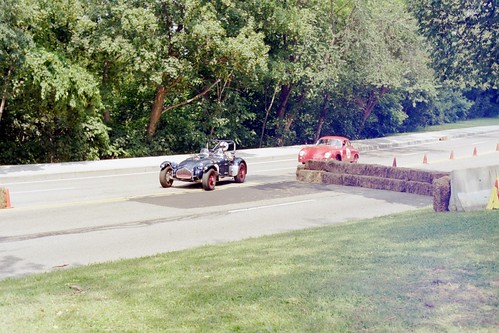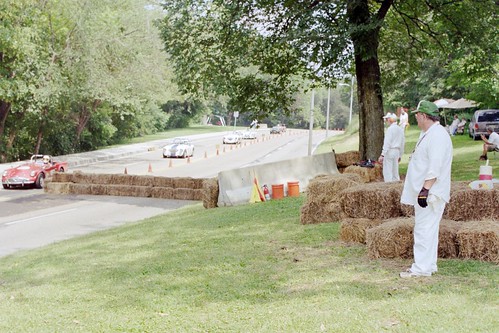The Pittsburgh Vintage Grand Prix ("Grand Prix") is a road race using vintage cars on the roads of Schenley Park, Pittsburgh. They are in classes defined in a variety of ways. Some by age ("Pre-war (WWII)"), some by engine size ("under 1 litre") others by some other, more complex definition ("Sport racers"). The Grand Prix has the distinction of being one of only a few such motor races that are held on actual city streets (as opposed to a course made for the purpose). It is in its 25th year, put on by volunteers, supplemented by volunteers from the Sports Car Club of America (SCCA) and the Vintage Sport Car Club of America. From the beginning it has also been associated with Myron Cole (sports caster of "Terrible Towel" fame), the Autism Society of Pittsburgh and the Allegheny Valley School. As Cole passed away this year, this year's Grand Prix was in his honor and the volunteer/staff shirts took on a Terrible Towel theme (more on this later).

My association with the Grand Prix was through the Amateur Radio Emergency Service (ARES). ARES groups have a practice of providing radio support to major events as practice for their real purpose, providing backup communications support for public service emergencies and disasters. As such, the organization of event support and public service support are the same. Mobilization of volunteers, establishment of net control, check-ins of operators on site, assignments of radio operators to either stations or as shadows of key officials, and operation over time. It provides practice for the operators, test assumptions on how to manage large events, verify operating procedures, and gives operators a chance to test their equipment when operating in field conditions over the course of a day. And it provides practice in supporting another organization as well as other public service agencies who are also working the event. In my case, as a relatively young operator (< 2 years), training in procedures and actual use of my equipment (and some suggestions on what will help me work better). My assignment at the Grand Prix was to work a corner station, consisting of a corner captain with associated flaggers and course crew. Since this was the first time I've worked this event, I was with two other operators who happened to be two Elmers of mine, Mike and Cathy, (An 'Elmer' is an experienced operator who assists new hams as they learn the practices of ham radio.) Mike and Cathy are a married couple who help with the Red Cross radio operations. They have a wonderful story, of how one of their first dates was when Mike worked the Grand Prix some 18 years ago. And Cathy enjoyed it so much she got her radio license, so she could work the Grand Prix without Mike in case they broke up. Apparently, this has not been an issue.

I was told that this particular corner was worked by two families (including Mike and Cathy) who have a long history of working the same corner for the Grand Prix year after year. We had "Sarge" and "Mom" who were the corner captain and the main flagger for the corner. Two sons and a daughter working the corner. A few others (including a couple) working to maintain that stretch of the course. And a few grandkids, including one (teenage) grandson helping with the course maintenance, and another grandson who dressed properly to help as able and needed, and other grandkids playing with the sound of the cars in the background. So in addition to carrying out their tasks, there was the passing down of traditions and practice down the generations. The tasks such as what the various flags were for. The use of hand and flag signals and whistles to communicate to the other workers and the drivers. Why all race workers dressed in white shirt and white pants. The complaints about the yellow t-shirts (because not only were they not the traditional road race white, they were yellow. Yellow and Red are forbidden colors on the race course because they are used on warning flags.) Having one grandson help with the flagging (holding a signal flag) and telling him he gets to brag at school of working on a race course. Hearing all the stories of how people got involved in racing, and everyone sharing of their lives and each other lives as the natural progression of years goes on. (birth, marriage, kids, deaths)

We learned of radio operation as well. Mike and Cathy showed me their setups, both their car, and a rig they set up to transmit television signals of the corner. We discussed equipment, such as the use of gun muffs over headphones to block out the roar of the cars. There was a conversation with Sarge and Mike about the sound blocking qualities of various types of muffs, down to the frequency response due to the different intended purposes of various type of ear protection. It was the first time I've worked for extended periods on simplex (not using a repeater) so I got an education on the qualities of different antenna as I compared reception of others from various places in the hills and valleys of Schenley Park. And Mike and Cathy provided commentary on the proper practice, from listening to others. They let me handle some routine communication. In addition, we took messages from the corner captain to send to race officials about the condition of cars, and reports on the condition of the corner. The most exciting thing was when one car sustained sudden damage, sending debris over the course. Which required that the course be closed and cars stopped. Because of the hills and valleys of the course, it is not possible to see the entire course, and having to make individual calls to the corners would be so inefficient, the use of a radio net is ideal for this, as several corners passed on information and requests to the net control and to the race stewards, letting the race officials make proper decisions on the running of the race and ensuring the safety of drivers, workers, and spectators. Which is what would happen in a real public service event.

And more education. Of how events are organized and how radio volunteers are recruited. The history of ARES is SW Pennsylvania. The personalities, mistakes, goals, expectations of radio operators and those who want them. All of which I actually need to know. Because it is a community that is hoping I take my place among them.

No comments:
Post a Comment